Tag: infographic
New Infographic On Chinese Pronunciation And Pinyin
29.09.2013 09:05:49
I'm delighted to share with you the great new infographic "Facts About Chinese Pronunciation in Plain English"
What is it, that makes Chinese pronunciation so hard when pinyin can seem so simple? Check it out with this infographic. It is divided into the following sections:
- 3 Reasons for learning pronunciation first
- 3 vs 4 on Pronunciation. The easy and the hard
- 3 vs 3 on Pinyin. The easy and the hard
- 5 Common misconceptions
- Why bother learn correct pronunciation?
- Become a pinyin superhero!
This infographic is a great supplement to the Standard Mandarin software for learning pronunciation and pinyin. If you have been struggling with Chinese pronunciation, you're probably going to find a few bits of amusement here.
I sincerely hope you will enjoy it. Click here to view it now (It's free)
During the coming weeks a number of blog posts will be submitted to the new StandardMandarin.com blog, to cover each section of the infographic in greater detail.
Please stay tuned
Infographic - 3 Reasons For Learning Chinese Pronunciation First
05.10.2013 06:02:27
This is the first blog post in a series to cover the contents of the infographic "Facts About Chinese Pronunciation in Plain English" Below is a snippet of it. Please click this link to view the whole infographic.
Let me introduce you to the characters in the infographic. The little girl on the left is Daisy, she is half Chinese and half western. Then there is the Chinese girl, we'll call her Daidai and then there is the western guy - John.
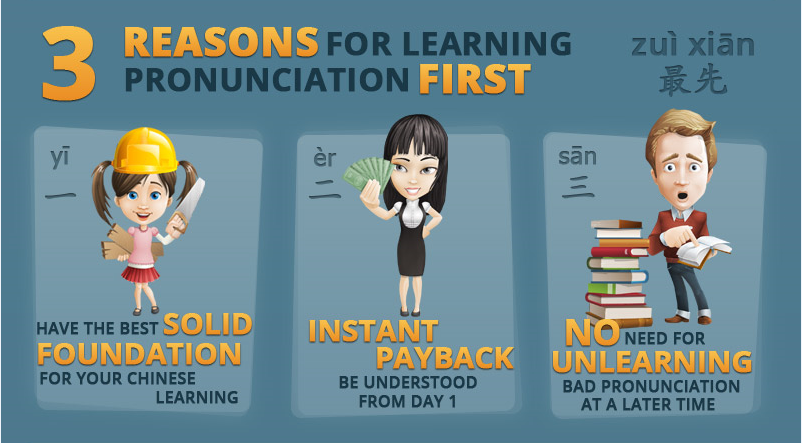
The Reasons
So what reasons are there for starting with learning the pronunciation part of the Chinese language? It can seem so hard.
Reason One - Foundation
When it comes to learning Chinese, pronunciation is hard to master for most foreigners. But no matter what you're going to say in Chinese, pronunciation will always be required. As soon as you master the pronunciation, it becomes so much easier to add more vocabulary and phrases. You will not have to struggle with the pronunciation of each new word, you just need to hear it once and you can say it perfectly immediately after.
Aiming at mastering the pronunciation first will give the great foundation you need to successfully learn Mandarin Chinese.
Reason Two - Instant Payback
It's awesome to have a great vocabulary or to have perfect grammar, but none of them will benefit you from the very first day.
Master pronunciation and any word or phrase you say will benefit from it immediately.
Reason Three - No Unlearning
It is almost impossible - if not absolutely impossible - to avoid getting something learned wrong. Whatever you learned wrong will stick with you for a long time, all the way until you do something deliberately about it.
Correcting one's own use of words learned wrong, can be quite difficult to fix. Fixing wrong pronunciation can be even harder.
Wrong pronunciation can be the hardest thing to unlearn. There is a simple way to avoid having to unlearn too much. Learn Chinese pronunciation properly before your brain and facial muscles has already decided how it wants to produce those odd Chinese sounds.
Take control, learn Chinese starting with the pronunciation.
Get the Standard Mandarin software to do just that.
Infographic - 3 vs 4 Points On Chinese Pronunciation, The Easy And The Hard
08.10.2013 13:18:20
Have you thought of what makes Chinese pronunciation easy? Well, most learners of Chinese can easily see what makes it hard. Just identifying the easy and the hard parts of it, might actually give you that extra knowledge which it takes to master Mandarin pronunciation.
Pronunciation - The Easy Part
Let's start with the easy part. Even though these points may seem simple, many never thought about it.
Pronunciation Systematized in Pinyin
 Can you imagine if there was no pinyin or any other form of soundscript? You would have to memorize the pronunciation for each of the many thousands of words you'd have to learn. That is almost the way foreigners learn English. Even though there are some phonetic systems for English, only few use it thinking they can read the word directly anyway.
Can you imagine if there was no pinyin or any other form of soundscript? You would have to memorize the pronunciation for each of the many thousands of words you'd have to learn. That is almost the way foreigners learn English. Even though there are some phonetic systems for English, only few use it thinking they can read the word directly anyway.
We are very lucky the Mandarin Chinese pronunciation is not more complicated than that it can all be fitted into a phonetic system such as pinyin. Other wise it would hardly be learnable.
Just 30 Basic Sounds
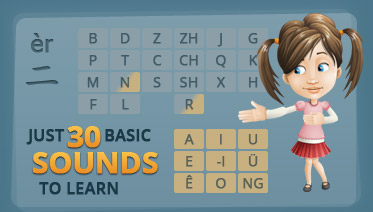 When you look at the the thousands of complicated Chinese characters or just the hundreds of possible pinyin syllables, you may be overwhelmed. But just think about this, if you master 30 basic sounds, then you have already learned every sound in Mandarin Chinese!
When you look at the the thousands of complicated Chinese characters or just the hundreds of possible pinyin syllables, you may be overwhelmed. But just think about this, if you master 30 basic sounds, then you have already learned every sound in Mandarin Chinese!
But it gets even better, please consider the next point.
Only 9 Tongue Positions
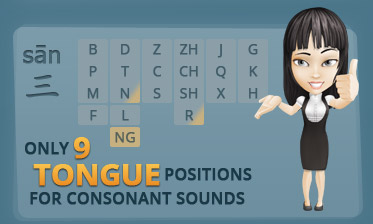 The 30 basic sounds are made up of 8 different vowel sounds, the remaining 22 consonant sounds can be produced with just 9 different tongue positions!
The 30 basic sounds are made up of 8 different vowel sounds, the remaining 22 consonant sounds can be produced with just 9 different tongue positions!
How is that possible? Are the 22 consonant sounds not different after all? Yes, they are different, but only to a certain extent. Take for example the letters Z, C and S. The only difference between these sounds is how big a puff you make, if any puff at all.
Please take a closer look at what Daidai is showing us in the infographic below. Look in the third illustration in the first column. There is a bunch of pinyin letters, and they are grouped according to tongue position. What do you think? Doesn't visualizing it this way make a seem a lot more do-able?
You may want to compare with the Anatomy section of the Standard Mandarin application.
Pronunciation - The Hard Part
All right, we are out of easy parts for the pronunciation, there is still 4 hard parts left. Identifying them may give you the upper hand in learning Chinese pronunciation. Let's get started.
Distinction Between Similar Sounds
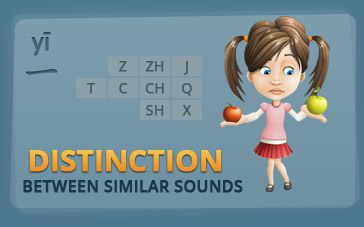 Yes, it can be quite hard to tell the difference between many of the Chinese sounds. That is also in part due to the fact, that they are basically the same. The only difference being, for example, how strong a puff you make, if any.
Yes, it can be quite hard to tell the difference between many of the Chinese sounds. That is also in part due to the fact, that they are basically the same. The only difference being, for example, how strong a puff you make, if any.
But even sounds that are not made with the same tongue position, can be hard to differentiate. For instance, many learners are tricked into thinking, that the letter 'T' is pronounced just like in English or some other western languages. The fact is, you will most likely need to learn the pronunciation of this all anew in order to differentiate it properly with the letter 'C'. And you must not fall into the other pit and pronounce 'T' like 'D'. That would be wrong as well.
Also, many find it particularly hard to hear the difference between ZH and J, CH and Q, SH and X.
How to deal with this effectively? Well, practice makes perfect.
4 Tones
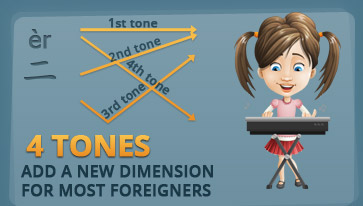 Granted, there are only so many different pronunciations in Chinese, but multiply that number with the 4 tones and it suddenly isn't that easy any more. On the other hand, when you master the 4 tones you can apply it on any syllable and thus the complexity is divided by 4 as well.
Granted, there are only so many different pronunciations in Chinese, but multiply that number with the 4 tones and it suddenly isn't that easy any more. On the other hand, when you master the 4 tones you can apply it on any syllable and thus the complexity is divided by 4 as well.
Tones as part of the language is a completely new thing to most western learners of Chinese. So it will take some time for most learners to get used to this.
Don't try and skip where the hedge is lowest, there is no way around it. The tones have to be learned.
3 Sounds of Tongue Splitting
 Don't worry, you don't need to actually split up your tongue. But to make the right sounds for J, Q and X you need to use your tongue in a completely new way. When you look at the Anatomy animation for these sounds, you may find that it looks almost like the tongue is splitting in two. Have fun!
Don't worry, you don't need to actually split up your tongue. But to make the right sounds for J, Q and X you need to use your tongue in a completely new way. When you look at the Anatomy animation for these sounds, you may find that it looks almost like the tongue is splitting in two. Have fun!
4 Sounds of Tongue Folding
These 4 sounds can be particularly hard to learn as well. These are often given most attention and are infamous for being very hard to learn. There are several reasons for that. One of them is simply that these sounds are hard to learn.
Another reason is that many Chinese people refer to these sounds as the 卷舌音 (Juǎn shé yīn). Which directly translated means "Roll Tongue Sound(s)". This name is probably the main reason why many Chinese natives actually think, you need to roll up your tongue and pull it far back towards your throat, in order to make these sounds properly.
Don't worry! That is not the way to make proper ZH, CH, SH and R sounds, also infamously known as 卷舌音 (Juǎn shé yīn).
Check out the Pronunciation Guide and Anatomy animations for these sounds in the Standard Mandarin software to learn it right. It really isn't that hard.
Another reason why these 4 sounds of tongue folding get so much attention, is the fact that people from southern China have a hard time pronouncing them. Some are even completely unable to do so, others are just too lazy to speak proper Mandarin.
Either way, even the 4 sounds of tongue folding are absolutely learnable for the foreign learner.

I hope you enjoyed this little walkthrough of the second section of the Infographic on Chinese Pronunciation and Pinyin. Check out the whole infographic here.
The section called "3 vs 4 - Pronunciation - The easy and the hard" is shown below.
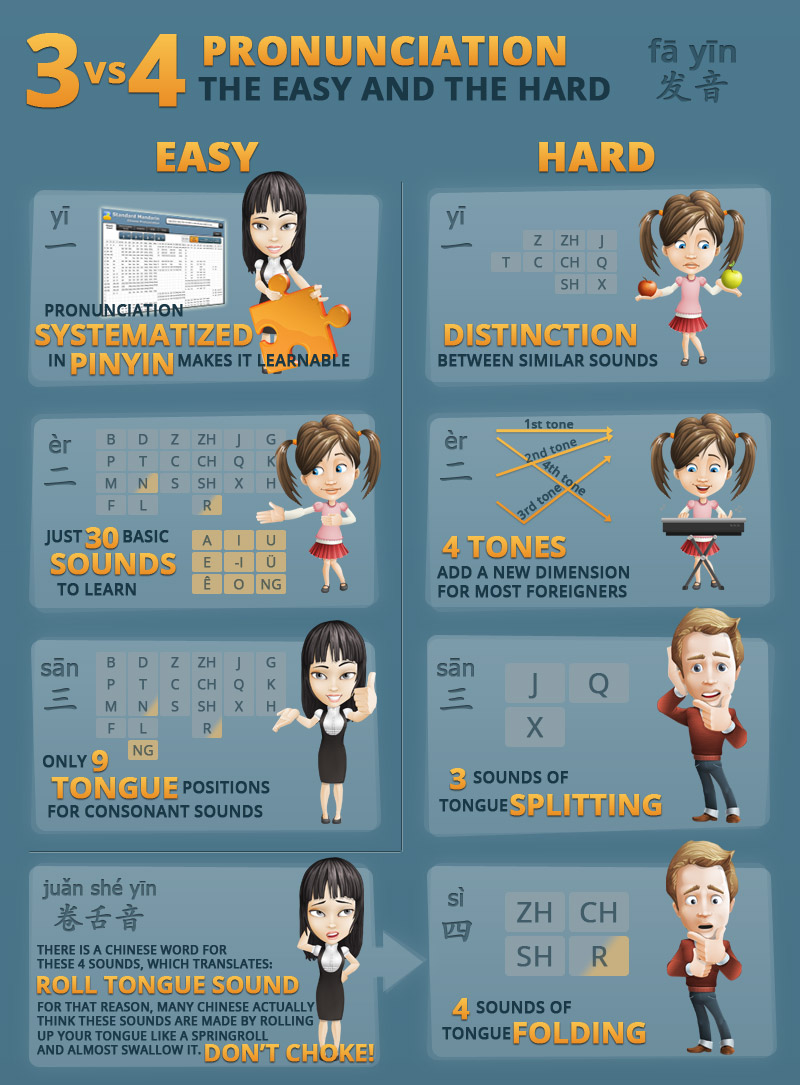
Infographic - Chinese Pinyin, the easy and the hard - 3 vs 3
18.10.2013 10:21:05
Didn't you feel relieved at first when you learned that Chinese has pinyin, to help you learn pronunciation? Many learners of Chinese even feel in the beginning that they could spare themselves a lot of effort if they just settle with learning pinyin, and forget about the characters.
It doesn't work that way though. If you want to learn proper Chinese conversation skills, you will have to get acquainted with the characters. That being said, let's look at the third section of the infographic on Chinese pronunciation and pinyin, which focuses on pinyin only.
What makes pinyin easy?
No Strange Symbols
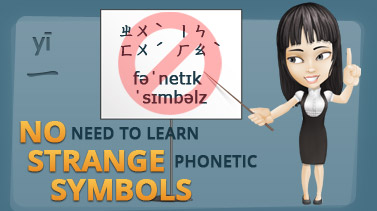
For one thing, we don't have to learn a whole new set of letters, symbols or characters. We are already familiar with all the letters in the pinyin system.
Pinyin isn't the only sound script out there. Take a look at what Daidai is teaching in the illustration here. Can you read the two first lines of.. well.. script? It is written in Zhuyin (aka "bopomofo"). Its pinyin equivalent would be "zhùyīn fúhào". So which do you prefer to learn?
Both pinyin and zhuyin is just a set of phonetic symbols carrying no meaning other than pure pronunciation. English has the same, since not all written words are pronounced exactly as they are written. Take an example, how do you pronounce the English word "read"? That would depend on the context. In some cases it must be pronounced like the word "red", whereas in other contexts it must be pronounced like the word "reed".
Are you able to read the last two lines of symbols in the illustration? What does it mean? It is in fact "soundscript" for the English words "phonetic symbols".
So the first good thing we can say about pinyin, is that it is quick to get started with. Just compare it with Zhuyin or even English phonetic symbols.
Fluency Quickly
 With a somewhat limited effort and short period of time, you will be able to achieve fluency in pinyin. You will be able to read it quite fast, even though you may not pronounce it all perfectly right.
With a somewhat limited effort and short period of time, you will be able to achieve fluency in pinyin. You will be able to read it quite fast, even though you may not pronounce it all perfectly right.
Achieving fluency is a good thing when you're in class, reading a message for a Chinese person - perhaps a taxi driver, or even if you, as part of some meeting, have to read or convey a written Chinese message.
Masterable
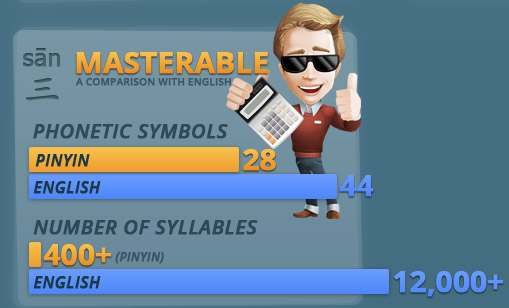
Here is both a fair and an unfair comparison between pinyin and English. If you take a close look at this, it might make you feel that getting to grips with pinyin is really not bad at all.
Phonetic Symbols
Let us first compare the number of symbols in pinyin and in an English phonetic system.
Pinyin has just 28 different basic symbols, whereas English has 44. These two numbers are directly comparable, since we're not comparing the very languages, just the phonetic symbols.
This is particularly interesting because many feel that there are so many very difficult sounds in Chinese. The fact is that Chinese has fewer sounds than English.
Number of syllables
This comparison is actually not really fair. You see, this comparison is between pinyin (sound script only) and English (the very language). The reason why it is still included here, is that quite a few western learners of Chinese decide to focus so heavily on pinyin, that they somewhat tend to see pinyin as the written language itself. While that cannot be recommended, lets get back to the comparison.
Ever thought of how many different syllables you'll encounter in English? A staggering 12.000, or even more! In pinyin there is just roughly 400. So you would actually be able to memorize the whole set of pinyin syllables, even without super-brain powers.
Could there possibly be any downsides to pinyin? Let's take a look.
What makes pinyin hard?
Pinyin is great, but it has some features that really make up some pitfalls for learners.
Learn ABC Again

The nice thing about pinyin is that you don't have to learn a whole new set of symbols or letters. But the downside to it, is that you would very likely have to put in a real struggle, in order to "unlearn" the pronunciation of some letters.
As an example, take the letter C, whether in the pinyin initial CH or just C, it is never pronounced like any of the C's in the English word 'cycle'. So every time you encounter the letter C, while reading pinyin, you must forget what you were taught from childhood regarding the letter C and apply the Chinese pronunciation on it instead. This can be troublesome.
The Fake 'I'
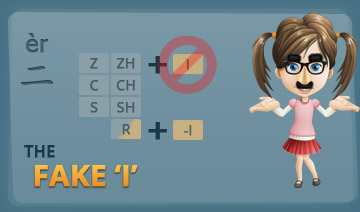
One of the very common pitfalls is the fake I. In fact, in pinyin there is the letter I and the letter -I. What is that supposed to mean?
You should really take a closer look at the Standard Mandarin pinyin chart. You can download and use the chart for reference free of charge here. Check out the two different columns with the finals 'I' and '-I'.
The thing is that the 'I' is pronounced like the 'ee' in 'bee'. This is not always the case however, if it is part of a pinyin syllable beginning with any of the following initials: Z, C, S, ZH, CH, SH, R.
So what is it pronounced like then? Actually, I'd prefer you to hear the sound for yourself. Just type in something like "SHI" in the "pinyin pronouncer" on the Standard Mandarin home page, and you can hear it. It is free.
The Standard Mandarin software also provides in-depth description of how to produce this sound.
'Ü' The Treacherous
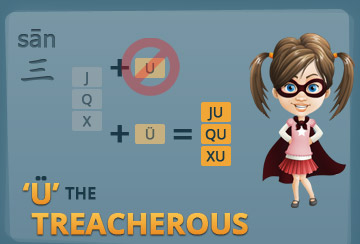
Another tricky letter in the pinyin system is the letter U, or Ü rather.
The letter Ü is especially tricky because in some cases it is written exactly as it is, with the umlaut dots. But in most cases it is rewritten as a regular U. This causes a lot of misreadings.
If the Ü is part of a syllable beginning with L or N, then it is not changed.
But if it is part of a syllable beginning with J, Q or X then the dots are simply omitted. Why? To save ink? Well, probably to make writing pinyin faster. The thing is that J, Q and X will appear in a syllable together with the regular U.
So whenever you see the J, Q and X together with a U, then remember that it is not really a U but a Ü.
Pinyin is great. It makes getting started with Chinese so much easier. It also has its pitfalls though. Don't just ignore the pitfalls, but get to know where they are, and cope with them. That will make you pinyin superstar!
Did you enjoy this little ride through the third section of the infographic on Chinese pronunciation and pinyin in plain English?
Check out the whole infographic here. The third section of it is right below.
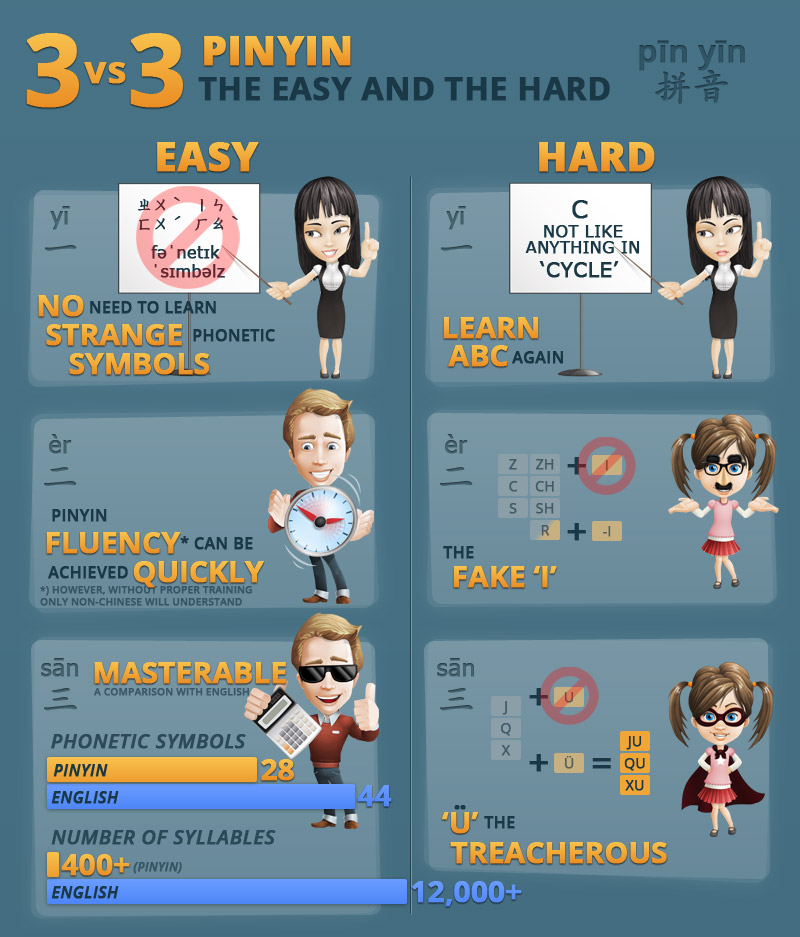
Infographic - 5 Common Misconceptions Regarding Learning Chinese
24.10.2013 08:08:25
Some misunderstandings are quite amusing, like this joke:
I said to my wife last night, "I fancy a takeaway."
She said, "Are you talking Chinese?"
I said, "No, did it sound Chinese?"
Misunderstandings or misconceptions can be fun, but they're not always that great. Below you'll find 5 common misconceptions regarding the Chinese language. I hope the associated illustrations will amuse you, in which case these misconceptions will be fun after all.
This is all part of the "Infographic on Chinese pronunciation and pinyin in plain English".
Myth: Singing In Chinese Is Impossible
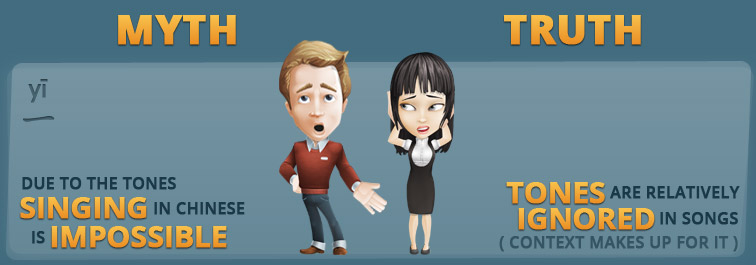
Some new learners of Chinese reason that singing in Chinese is impossible, since all the tones for each word are already fixed, giving no leeway for singing.
That's just outright wrong.
There are at least two simple reasons why singing is possible in Chinese.
- If the melody requires a certain word to be sung in a tone different from its original tone, then melody will overrule and the syllable's tone will be ignored relatively.
- The tones in mandarin Chinese are not fixed absolutely. If they were, it would be impossible to convey feelings and emotions through tone of voice, modulation, sense stress and so on. In daily speech, words are emphasized naturally by stretching some tones and shortening others. So while tones are very important in Chinese, they can still be "bent", and this is done to a great extent in Chinese songs.
Myth: Pinyin Is Like Chinese Pidgin

This myth is a sad result of the otherwise great pinyin system. Some new learners of Chinese think, when they see pinyin, that this looks so familiar, that they start treating it like some sort of Chinese pidgin. Please don't!
Pinyin is nothing like pidgin. Pinyin is a phonetic system, it isn't a language. As a Chinese learner progresses he will realize that while learning pinyin might have been the primary basis for his conversational skills, learning Chinese characters will give him the real understanding of the language needed to develop his conversational skills further.
Pidgin is the resulting language, evolving out of the simplified use of a certain language, English for example. The learner has his own language, and there is the language he is learning (perhaps English). If he and a number of other learners don't learn the new language properly, then a third hybrid language evolves. Such language is called "pidgin". You wouldn't want to speak "Chinese pidgin", unless of course, all you aim at is to be understood by your fellow Chinese-learning classmates.
Myth: J Is Pronounced Exactly As In Jeep

The myth that J is pronounced exactly as J in Jeep is a very common misconception found on the internet. This myth is really an oversimplification. It really isn't that simple. True, it is a quick way to learn, but it is also incorrect.
If you put in the little extra effort and get this pronunciation right, from the beginning, then it will serve you well! In particular because the pronunciation of J is closely linked to the pronunciation of Q and X. These can be quite difficult to learn, so don't settle with an average pronunciation of J, when it could serve as a stepping stone to mastering more complex sounds.
Get the Standard Mandarin software to learn it right. It has a great section on anatomy and a pronunciation guide, with which you will learn to master Chinese pronunciation. You'll even be more aware of how to produce mandarin sounds, than the native Chinese.
Myth: Chi And Che Is Basically The Same Thing
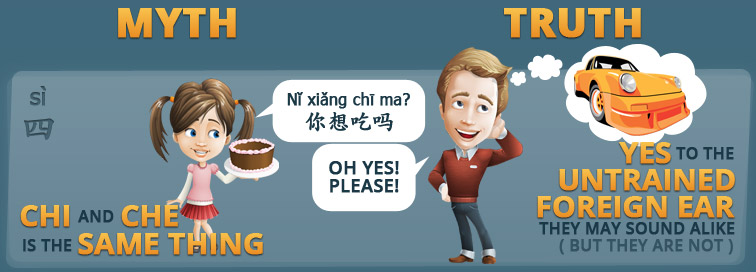
Yes, to the untrained foreign ear CHI and CHE sound alike. The truth is, they are not.
It is true that you may be understood most of the time, even if you're making no distinction between the two sounds. But your speech will seem cluttered and unclear.
Check out the illustration above. Not making clear distinction between these sounds will give cause to more language misunderstandings. The little girl (Daisy) is asking the guy (John) whether he'd like to have some cake. He, though, is unable to hear the difference between CHI and CHE, so in his ears, he is hearing "Are you thinking about a car?"
There is a reason why there are both the syllables CHI and CHE. They do not represent the same sounds.
Myth: Wrong Tone Will Most Likely Result In A Misunderstanding
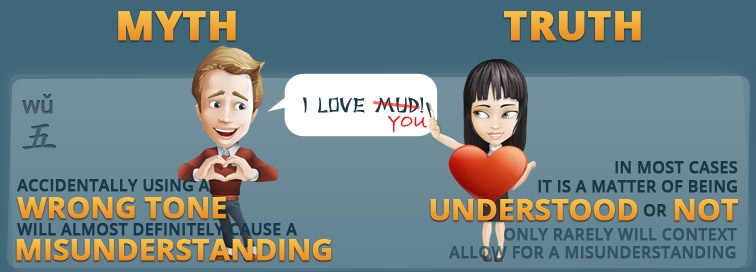
Fortunately this is not the case. Most tonal mistakes don't cause more harm than that the listener needs a little extra time to process the sound before he understands.
The truth is that only in very rare cases, will a tonal mistake allow for any other understanding than the intended. So if you're not understood correctly, chances are you not misunderstood either.
It is still true though, that using a wrong tone may result in a major misunderstanding. If that should happen to you, which it probably will some day, then try and enjoy the fact that you have amused your listener. It is healthy for him to smile or even laugh, and it is healthier for you to find joy in it, rather than be overly worried about making mistakes.
Did you enjoy this walkthrough of the fourth section of the infographic on Chinese pronunciation and pinyin? Check out the entire infographic right here.
If you would like to learn more Chinese pronunciation and pinyin, please download the Standard Mandarin software. You can download it for free here.
Below is the entire fourth section of the infographic.
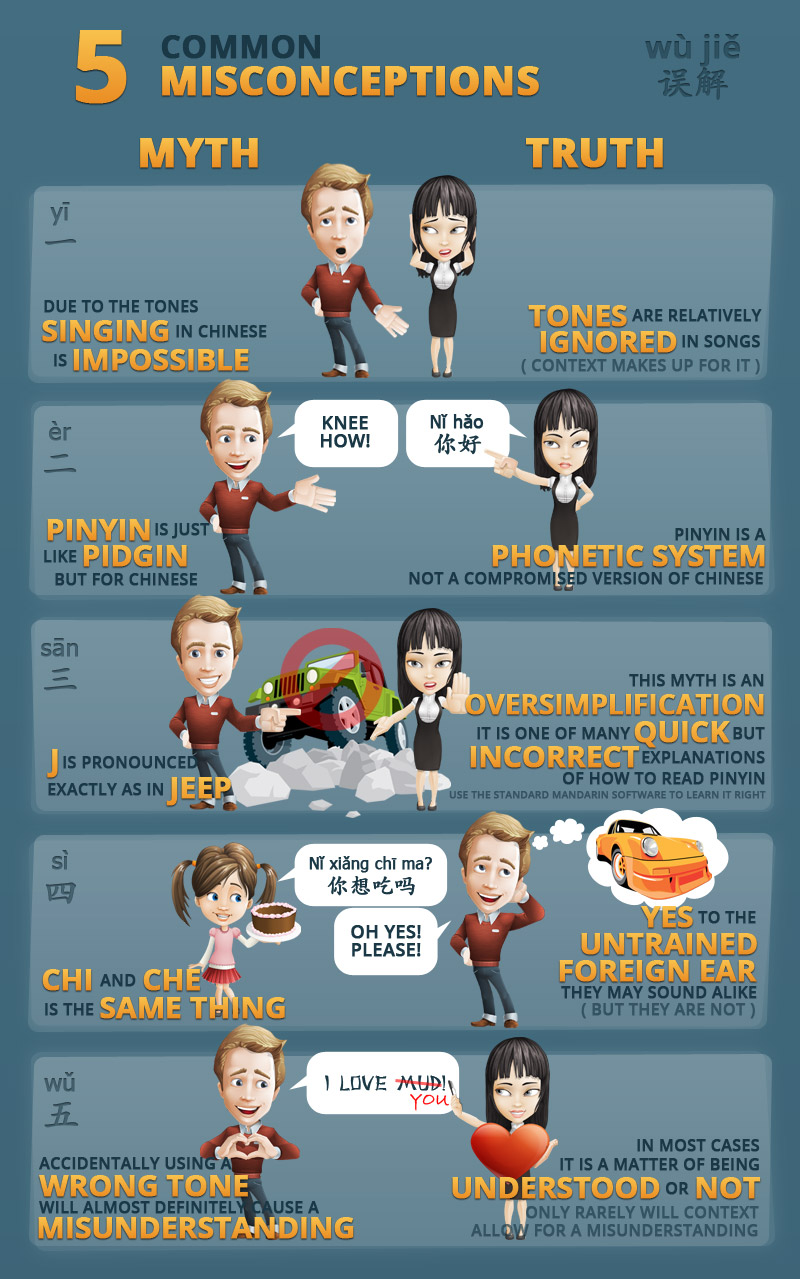
Infographic - Why bother learn correct pronunciation?
30.10.2013 12:19:14
Since pinyin is so easy to get started with, and since with it you can expand your Chinese vocabulary in no time, why would you then bother put so much effort into learning correct pronunciation? Why not just add some grammar, vocabulary, a few idioms and settle with an average level of Chinese? That would impress most people anyway, wouldn't it?
Well, you might decide to do it that way. But if you intend to learn more than the survival Chinese for a single travel journey to China, then you will definitely not regret spending the needed effort on pronunciation.
Why is that?
Weightier Than Anything

When it comes to learning mandarin Chinese, the pronunciation is weightier than anything else. Naturally you would need to learn at least the most basic vocabulary, otherwise there is nothing to apply great pronunciation on. However, the Chinese can tell immediately whether you have good pronunciation, which they really appreciate.
The thing is, even if you know all the grammar rules and their exceptions, as well as a good deal of idioms, not to mention having a great vocabulary, what is it worth? If whatever you say, the Chinese guy has to muddle his way through deciphering the sounds you produce? Chances are, he will start thinking you're merely trying to say the most simple things in Chinese, so whatever depth you intended to express, gets lost in pronunciation.
Chinese people are also very much aware of how people from different parts of China pronounce things. They don't mind the grammar that much. If you step in the door with great pronunciation, then they immediately view you as being very proficient at Chinese - even if you only have limited vocabulary.
One natural reason for pronunciation paying off so much more praise than grammar for example, is that it requires the listener to carefully analyze your grammar in order to evaluate your proficiency in it.
Another thing is that if you are good with idioms (Chengyu) then you need to know how to pronounce them anyway. The Chinese listener will not expect you to speak idioms, so context is not your side. At the same time, you need to be lucky to know idioms appropriate for the situation. Use a wrong idiom and you have exposed yourself as an amateur in Chinese language. A pitfall when it comes to idioms is that if you're too keen with them, you may be frowned upon for showing off your Chinese skills. You may even score an own goal if you try and impress with idioms that the Chinese listeners don't even know. Do I say you shouldn't use idioms? No. It is just a lot easier to impress with good pronunciation.
Pronunciation weighs a lot heavier than grammar, vocabulary and idioms. Don't try to leap over where the hedge is lowest on this. Pronunciation is absolutely the easiest and best way to harvest praise.
Correct Pronunciation Gets You Tons of Praise

This is no exaggeration, correct pronunciation gets you tons of praise. If you have good pronunciation, you will easily get Chinese people praising you to the point where they insist that your Chinese is even better than theirs.
Of course, unless you easily get puffed up by such praise, you know that that can't possibly be true. If you start digging into it, you will find they are aware that your vocabulary and grammar might be far from perfect, but your pronunciation may be more "standard" than theirs - even in their most sincere opinion. If you put in the required effort, you would be able to achieve an accent-free mandarin pronunciation.
The Chinese are generally very generous with praise. It can get you into the Cycle of Praise.
Cycle of Praise

Receive Praise
Who wouldn't feel great with so much praise?
You're probably not learning Chinese merely to receive praise, but it surely does make one feel good. Proper Chinese pronunciation is the key to that. What does all that wonderful praise lead to?

Joy Boost
All the wonderful praise we get results in a real joy boost. Which instantly takes you to the next great feeling.

Motivation
We don't need a scientific education to figure out, that the joy boost instantly transforms into great motivation to continue with our efforts.

Study On
The motivation we get leads us to the beautiful result, namely that we continue to study on. And what does that lead to? We improve our Chinese and become even better. So already it this point, we reap great benefits from the praise we like so much.
It is not over yet though. With improved Chinese we are going to receive even more praise, and so we have placed ourselves in the great and inspiring Cycle of Praise. Enjoy!
How did you like this walk-through of the 5th section of the great infographic on Chinese pronunciation and pinyin? You can see the whole section below, or click this link to see the entire infographic right here.
You may also be interested in the article about motivation - How to keep up your self-study project.
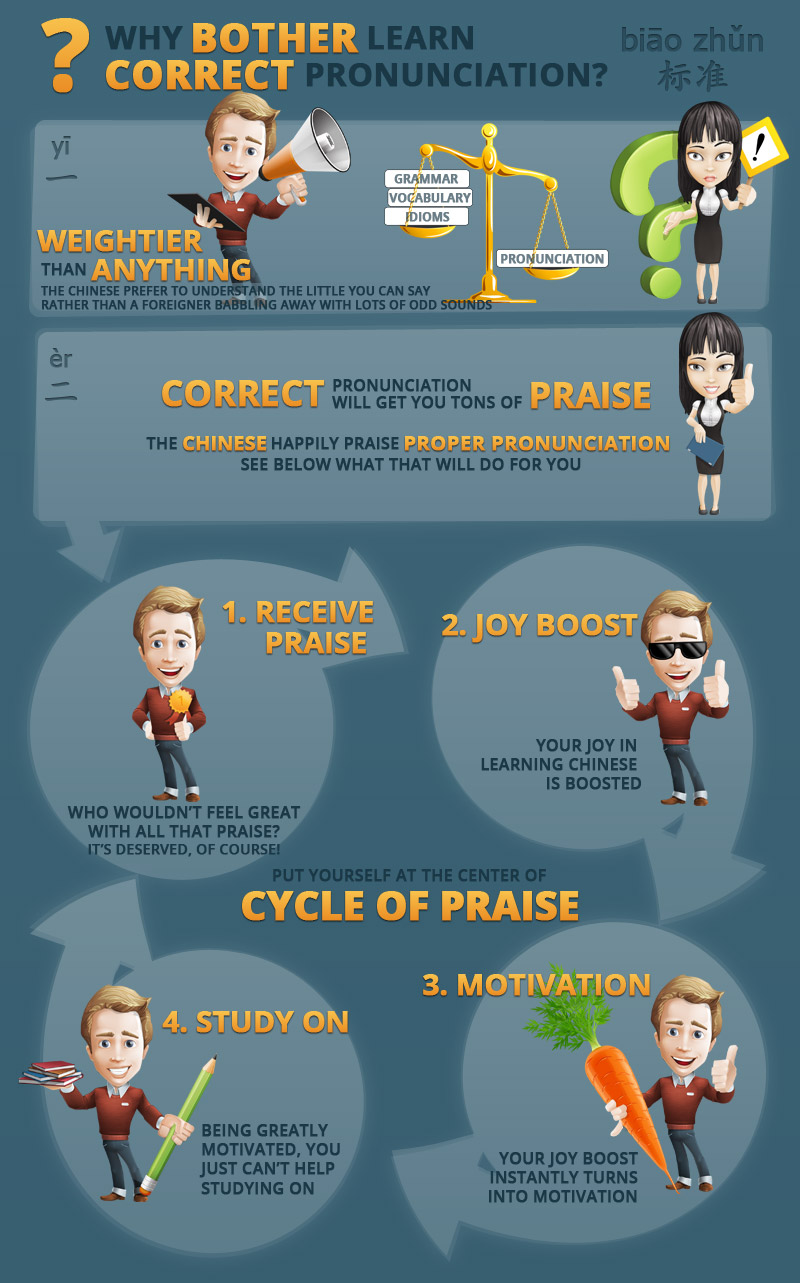
Become a Pinyin Super Hero
10.12.2013 14:23:42
What is that? Is it a bird? Is it an airplane? No, it is the Pinyin Super Hero!
40 million people worldwide are learning Chinese, according to some estimates. You can stand out, by perfecting your pronunciation. Starting sooner is much better than later.
Though pinyin may seem simple, the infographic on Chinese pronunciation and pinyin shows that there is more to it than meets the eye. Still, becoming an expert in the field of pinyin is achievable!
The Standard Mandarin software can help you on your pinyin learning quest. Except from letting you hear all the pinyin sounds with a clear and steady voice, it also provides very concise and accurate description of how to use our facial muscles to produce the standard Chinese pronunciation you are after.
One of the greatest features of the software is the anatomy animations. Most of us prefer (and almost need) to see things visually to actually understand. These animations allow you to see how to use your mouth, tongue, lips and so on to pronounce mandarin sounds.
You're most welcome to download it here already now, and check out how it works. You can test it with the pinyin syllable "ba".

This is the final (and quite advertising) blog post covering the last bit of the infographic on Chinese pronunciation and pinyin in plain English.
If you missed the previous 5 blog posts on this topic, you may check them out here:

